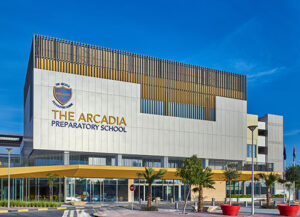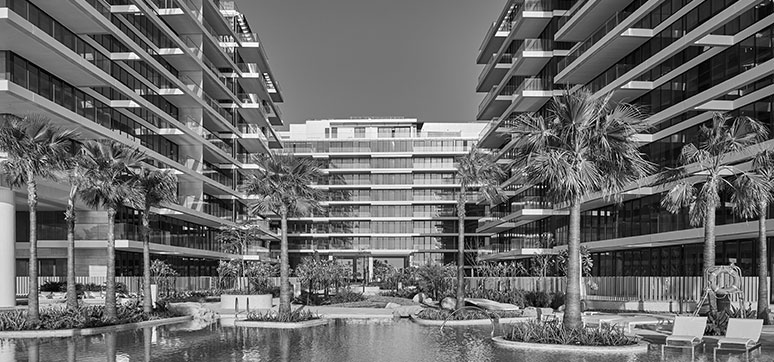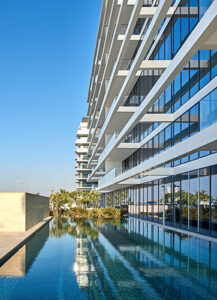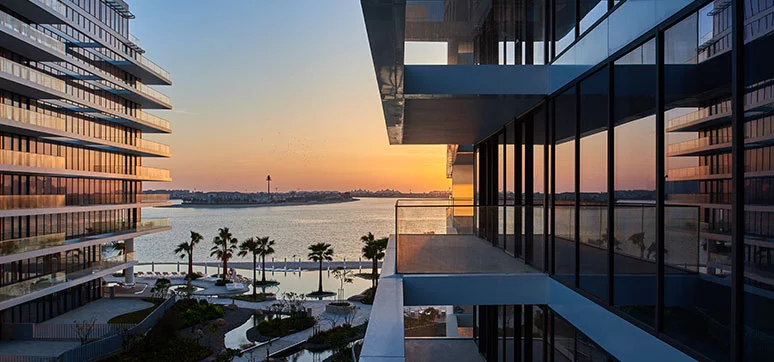What are the important tools for creating future façades?
Traditionally, we have always used general rules of climatology for designing façade by assessing the solar gains. With the emergence of AI and machine learning, we will be able to analyse real-time data for actual solar gains and general weather data through accurate simulations which, in turn, will allow us to design better, more energy-efficient façades. Façades in the future will be more accurate in terms of mitigating solar gains and optimising the overall views from the building providing and adding to improved occupant experiences.
What are the future opportunities for smart façades, adaptive façades & integrated façades?
Smart façades are modern façades that provide optimal thermal comfort at the same time reducing the building’s carbon footprint through a number of active measures. These can be mechanical measures, chromogenic controls or integrated photovoltaic which provide shade and power to the building.
Occupier comfort and aesthetics continue to be the main goal for us as architects. But it is equally important to lower energy consumption at the same time. Buildings in the future will move towards becoming more self-sustaining by generating a major part of electricity from façades which will offset general grid electricity.
What are the current advancements in façade & cladding technologies and

materials?
With the advent of active façade technology, the façade is no longer a fixed
dormant fabric. It has become a live enclosure that responds to the climate and to the occupant adapting accordingly. Glass, as an important element of any façade, has also become more energy-efficient in recent years.
Please brief about automation in façades and fenestration. What are the benefits?
The main benefits of automation in façades are the active measures to reduce solar gains and optimise the natural light inside the building without overheating or overcooling the internal environment while, at the same time, maximising views and daylight while reducing the heating and cooling loads.
This automation uses mechanical and electrical shading devices incorporated in the building fabric which work on real-time sensors and prevailing weather conditions and are activated to increase or reduce internal lighting levels accordingly. The long-term benefits have reduced operational costs of the building, better returns for stakeholders and optimal comfort for end users.
What are interactive façades, their benefits and limitations?
An interactive façade is a building fabric that reacts to real-time data generated from the building’s exteriors. A change in light or temperature engages the daylight controls which can be either mechanical or electrical shading devices. These then help balance the light and heat flow into the building, reducing the dependency on electric lights and heating/cooling of the built form. There are, however, cost implications for the initial capital costs and the technology which tends to deter building owners who are not aware of the long-term cost savings of the technology. But with time, this technology will be more prevalent with more owners making the investment.
What are energy harvesting façades? How do you see their future?
Energy harvesting façades are those which use the building components to generate energy creating a more sustainable approach to architecture. Currently, the efficiency of power generated through building integrated windmills and PV cells is low, but, as the technology improves, we will see these energy harvesting façades become more efficient in the future.
Energy harvesting will also work with self-cleaning glazed façades offsetting much of the energy used by the built form reducing the carbon footprint considerably.
What are the key characteristics of a high-performance façade?
High-performance façades are those which react to and work with real-time data generated from the building exterior.

What features do you see or want to see in the future façade?
Personally, I believe future façades should be a lot more sustainable with fewer solid elements and based on real-time parameters. I think we will see more vertical gardens or living walls, replacing traditional glass-clad buildings to help reduce the urban heat island effect and thus the overall energy usage of the building. I also believe we will see a lot more building Internet of Things (IoT) with much more data being generated by buildings and controlling the active façade elements.

What are your views on interactive façade? What are the advantages and limitations of media/ interactive façades?
There is a promising future for interactive façades. which allows for the control of light and heat in the building balancing the interiors for maximum occupier comfort at the same time as offsetting the electricity requirement to maintain the interior environment.
What façade material is your favourite and why?
Glass and mineral board cladding materials have been my preferred choice to date. Glass has always been an important material for aesthetic reasons and for the fact that it provides good quality light within the building. Mineral boards, on the other hand, look more natural and give a minimal look to a building.
What is meant by a sustainable and efficient fenestration? What are the characteristics and key features of sustainable façades and fenestration?
Sustainable and energy-efficient fenestrations are building envelopes which are sustainable in nature and, in parallel, help reduce energy usage for cooling or heating the building. The sustainability factor comes from the material selection, its fabrication, installation and the final reuse or recycling once the life cycle is over. Care must be taken at all stages of manufacture to ensure that we keep the carbon footprint to a minimum.














